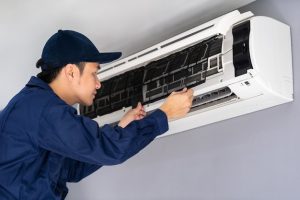Air conditioning is a great way to stay comfortable all summer long. However, it can also be an annoyance in some seasons. You know, when the sun relentlessly beats down or when there is a sudden rise in temperature and humidity that makes you feel like there’s a wall of air just outside your window. It can be pretty annoying when your air conditioner does not function as it should. Fortunately, not every AC issue is out of reach. If you follow the right steps and have the right resources at hand, you can easily resolve most AC problems.
What you will Need:
- – A flashlight
This will come in handy when inspecting the unit.
- – Extra set of hands
One person is enough for removing the unit’s parts if you don’t have a power screwdriver.
- – A screwdriver set
These will help you take off broken parts and remove the unit’s screws. A bit of duct tape can be a lifesaver in this situation.
- – A pencil
This will come in handy when marking the position of each part on the floor.
- – A sharp twine or scotch tape measure
This will come in handy when marking the position of each part on the ductwork.
- – A thermometer
This will help you keep an eye on the unit’s temperature and check if there are any leaks.
- – A humidifier
This will help get rid of excess dry air inside the system.
Step 1: Check the unit for obvious signs of trouble.
When you’re planning an air conditioning repair, it is a good idea to do a quick inspection of the unit. Doing so will help you find signs of trouble and possibly prevent a problem from developing. Here are some things you should look out for:
- – Dirty condensate lines
A dirty condensate line is a sign that your unit isn’t pulling moisture from the air efficiently. You can fix this by cleaning the line or installing a dehumidifier.
- – Excess dust
If you notice dust hovering around the unit’s compressor, this may be a sign that the unit is not cleaned regularly. A quick cleaning and inspection will solve this problem.
- – Signs of leakage
A leaking unit is a big problem. You can easily prevent this by inspecting the unit for signs of leakage. Make sure all the joints are tight and that there aren’t any signs of water damage.
Step 2: Put on your safety gear.
Before you start disassembling the unit, you might want to put on your safety gear. Air conditioning units contain electricity and chemicals. So, you should wear rubber gloves, goggles, and a face mask to prevent yourself from getting shocked or splashed with nasty liquid. It is also a good idea to wear sturdy shoes when you’re working on the system’s ductwork.
Step 3: Disassemble the unit and find out what is wrong.
Before you start taking off the unit’s parts, you should write down the unit’s technical details. This will come in handy when you’re taking off the unit’s parts and replacing parts. To disassemble the unit, turn off the electricity first. Use a screwdriver to take off the decorative cover at the outdoor unit. Next, remove the unit’s screws with a screwdriver. If you have a power screwdriver, use it to take off the unit’s screws. Once you have removed the unit’s parts, place them in a container or on the floor. This will help you leave no confusion or dust when reassembling the unit.
Step 4: Repair as necessary.
Before you start taking off parts, it is a good idea to inspect each part and try to determine what’s wrong with it. To do so, take a pencil and mark the position of each part on the floor or ductwork. This will help you keep the parts in place as you start removing them. If you notice a loose or broken part, you can try to fix it before taking it apart. You can use a bit of duct tape to seal a broken part while you can use a pencil to fix a loose or damaged condensate line.
Step 5: Reassemble and test.
Once you have taken off the unit’s parts and inspected them, it’s time to put them back together. Make sure you put back all the parts in the right position. Use duct tape to seal any joints if you notice any leaks. To test the unit, set up a thermometer outside the unit and a humidifier inside the unit. These will help you keep an eye on the unit’s temperature and prevent any overheating or under-humidifying. You can also try to reassemble the unit yourself if you do not have any other option. You just need to make sure you follow the manufacturer’s instructions carefully.
Conclusion
When your air conditioner stops cooling or heating your home, do not panic. You can easily resolve most AC issues with the help of these tips. Remember, a broken air conditioner is still a machine and can be repaired. If you are struggling with an air conditioner issue, do not hesitate to contact a reputable air conditioning company near you.

